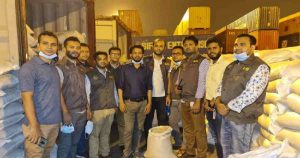Factors that Determine the Vulnerability of Women during Natural Disasters in Bangladesh
Iffat Ara Jasmin
Climate change is a non-traditional security issue that has global implications around the world. The Intergovernmental Panel on Climate Change (IPCC) presented scientific findings in 1991 on the evidence of global warming, emission increase, changes in biodiversity and raised alarm globally. Former UN Secretary General Ban Ki-moon declared that climate change is an “unholy brew” that can create dangerous security vacuums and that we must address the clear danger that not only exacerbates the threats but is itself a threat to international peace and security. Most research statistics show the numbers of deaths of women due to natural disaster were higher than men for example- in 1991, during the cyclone and floods in Bangladesh, of the 140,000 people who died 90% were women. In the last 25 years, Bangladesh has experienced six severe floods in 1984, 1987, 1988, 1998, 2004 and 2007 with damages and many deaths of populations. The 5th assessment of IPCC reveals that Bangladesh is identified as being at specific risks from climate change due to its exposure to sea-level rise and extreme events and Bangladesh’s population at risk at sea level rise is predicted to grow to 27 million by 2050. In these circumstances, there is no doubt that the frequency of natural disasters will increase more and women have to suffer much due to household burdens and various cultural norms.
Women play the pioneer role regarding coping strategies or mechanism and also ensure the survival of their families. But most of the time women do not get recognition of their contributions and sacrifices and people also cannot understand their hardships and contributions. Therefore the present paper is aimed to explore the determining factors that increase the various types of socio-economic, cultural and security problems or vulnerabilities of women during natural disasters.
From my field experiences I have found that during disasters women have to play the “triple role” such as-reproductive, productive and community management. They do reproductive work such as – raising children, clean houses, utensils, furniture, wash cloths -, do agricultural works such as – cut the Paddy, Jute, Papaya, Brinjal, Cucurbit in order to save the crops from destruction. Along with this, they have to do productive work as a family can’t afford even 2 times food during such time. Thus, some do handicrafts, woven mat or stitch kantha. Sometimes, women also make earthen stoves and sell them to others. Further, at disaster time some also repair home and animal shed. Moreover, they do community management work such as – collect water, fuel, food for the survival of their families and also have to take care of adults and near and dear ones. Such types of “additional burden” during disasters increase the vulnerability of women.
The “gendered division of labour” refers to the allocation of different jobs or types of work (both paid and unpaid work) to women and men in “public and private sphere”. In feminist economics, the institutional rules, norms and practices that govern the allocation of tasks between women and men and girls and boys also constitute the gendered division of labour. Due to gendered division of labour, most of the time women are barred from work outside during disasters as they have to do household work, collect water, fuel or food, so husbands didn’t allow them. Most women argued that they were capable to buy things according to their choices and demands when they work but now they lost the respect, independence and self-reliance and they are also excluded from their family decision making process as they are barred to work outside. No one even asks what they ate, their condition of health, happiness or fitness. Though they work hard and sometimes even do not sleep at night, no one cares for their sacrifices. This division encourages society to force women to stay at home and encourages men to work outside that is paid work. In this way, this kind of gendered division of labour increases the vulnerability of women during disasters.
“Family structure” also determines vulnerability. My findings showed that in single family women have to do less work. And in joint family elders and mothers-in-law gave additional work to their daughter-in-law’s during disasters. A single earner household, due to constraints of resources perhaps can’t meet the needs of women because their needs and happiness are ignored always and on the other hand, in the double earner household, if husband and wife both work, then it may fulfil the needs of a woman to some extent. In terms of married vs widow women, the widow has to suffer much in the society as men give bad intention towards them. In this context, a young widow suffers much difficulty. Thus, family structure contributes to the vulnerability of women during disasters.
Vulnerability depends on “social networks” during disasters and this network depends on a lot of factors such as- social status, amount of money, no. of days and no. of people. With a lot of people and with less money it is difficult to stay for a long period in a relative’s house. But all women agree that to go relative’s house is better rather than stay at school or remain without roof due to security problems. Those who have no social networks during disasters have to suffer more than others.
During disasters, “Group identity conflicts” occur in the destination place and home place between two different communities or even in the same communities regarding capturing and constraints of natural resources. Most of this group identity conflict occurs among women from different or same community. From my field experiences, most women said that local women quarrelled, taunted, humiliated and didn’t fill the pot first to the migrated women and they had to wait 2 or 3 hours while they go for collecting water. Sometimes they weren’t allowed to fill more than 1 pot and had to come again and again when water ends. Due to group identity conflicts, migrated women suffer most in this context.
Cultural Aspects: “Gender stereotypes and social dogmas” increases women’s vulnerability more during disasters specially during floods. From interview and FGD (Focus Group Discussions), most women said that being a woman they are taught to eat less than boys and don’t eat before their husbands, so during disaster already there is food shortage and they have to drink only water, eat parched rice and sometimes gruel rice where their husbands and boys eat hotchpotch and other healthy foods. This type of division between male and female creates malnutrition problems for women. Many women said that due to floods during menstruation they suffered much as it is considered ‘bad blood’, so their family confined them in 1 room where mosquito and other insects bite them and there is a bad smell in the water. Those who stayed at school couldn’t sleep at night as they had to dry their rags so that no one sees this.
There are various types of “superstitions or beliefs” in the society that a pregnant woman can’t eat potato and cucurbit because if she eats potato then her child’s eye will be round and if she eats cucurbit then her child’s body much hair will be grown. But during floods & river erosion, these potatoes and cucurbits are collected in the high place (‘macha’) of the house. But this restriction further adds more vulnerability for pregnant women results with underweight babies sometimes. Many women argued that they weren’t allowed to eat parsley (‘Shak’) and eggs during menstruation because there is the belief that who eats parsley her menstruation blood will be more dark and this dark spot can dirty clothes and also isn’t good for health. They also said that, during menstruation, eggs are also restricted for women as she who eats egg her menstruation will be severe bad smell. Thus, parsley and eggs are barred for women during menstruation. Due to shortage of foods during disasters, such restriction adds more hardships or problems for women and leave them with malnutrition.
Security Aspects: Most women face various types of “Emotional and Physical violence” such as- taunts and torture from their family members during disasters. They argued that as male members lost their jobs during disasters, so they are always tempered and beat them and their child with little or no reason. Most of the women said that their husbands and mother-in-law beat and taunt them if their cooking isn’t ready on due time. They also beat them if they return home late while collecting food, fuel and water for them.
Most of the women face “sexual harassment” during disasters when they move or relocate to another place. Male people give bad comment, touches them intentionally in wet clothes and look at them with bad intention while bathing. Unmarried and young girls face severe security problems while people come from another village. Displaced women who take shelter in the school, cannot sleep at night properly at the fear of displacing their cloth while sleeping and mothers cannot properly do breastfeeding due to bad intentions of other men. Here, also women face sexual harassment as lots of people shelter during a disaster and show bad intention over women.
Conclusion: Finally, we can say that level of Poverty, resources, family structure, social networks, capacity to adapt, skills, legal framework, rights, political representation, empowerment, cultural norms, security etc all factors combines during disasters and increases gender vulnerability. In general, women contribute more to a common good than do men and they are more aware of social bonds, showing greater reciprocity and altruism. They play the most important and pioneer role during any disaster but their contribution, rights and demands, special needs all are ignored in this patriarchal society that hinders the path of development of the country. So, we have to incorporate them in every policy that can contribute to minimize the negative effect and develop their livelihoods.
(Iffat Ara Jasmin, is a Junior Consultant, International Food Policy Research Institute (IFPRI) Dhaka.)




